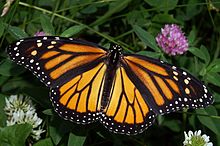Sad news about what some of us already suspected: the monarch butterfly population appears to be down this year at the insects’ overwintering site in Mexico.
The Fall Migration News notes that only 10 trees were filled with the delicate orange and black butterflies this November at El Rosario Sanctuary, compared to 60 trees just two years ago.
According to the fall update, every December, scientists visit the 12 traditional wintering sites and measure the area of forest the monarchs occupy. This chart shows the data scientists have collected for 19 years. Official results for this winter will be released in March 2014.
Among the artwork currently on display at C.S.P.S. Hall in Cedar Rapids is one piece that points to the connection between Mexican drug cartels and the declining habitat for monarchs, on a mountaintop of central Mexico where illegal logging to fund the cartels has been rampant.
Here in the states, farmers’ use of genetically modified crops and herbicides has devastated the amount of milkweed available as the monarch caterpillars’ only food source, according to many studies.
Finally, Laura Jesse, entomologist with Iowa State University Extension, whose tweet directed me to the monarch count info, posted this reflection of her connections to the butterfly.
Do what you can to save this beautiful insect. Avoid using pesticides and let your milkweed grow!


No Comments Yet